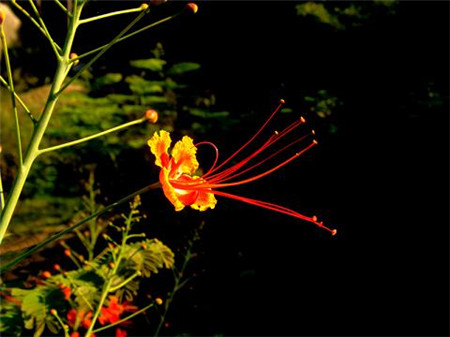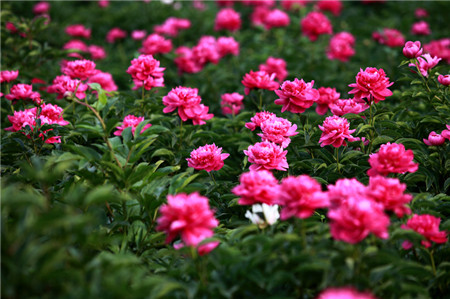Cultivation and Management of Phoenix Flower (Phoenix Tree)
Phoenix flower (Phoenix flower) is light-loving and not cold-resistant, grows rapidly, has well-developed roots, and has poor resistance to smoke and dust. Native to Madagascar, it is often cultivated in tropical areas of the world and cultivated in Yunnan, Guangxi, Guangdong, Fujian, Taiwan and other provinces of China.
Reproduction method
Most of the seeds are sown and propagated. After the fruits are ripe and collected, the pods are exposed to the sun. The pods split naturally, or they are beaten with a stick, and the seeds fall off. The 1000-seed weight of the seed is 480-520g. The seeds are stored in a dry, cool and ventilated place in gunny bags and stored for more than 1 year. The seed coat is dense and hard. Soak the seeds in 80 degrees Celsius hot water twice the seed volume for 24 hours before sowing (natural cooling), then rinse with clean water, and then soak the seeds in 50 degrees Celsius hot water for 24 hours. Sow on the seedling bed, cover the soil 0.5 centimeters, pay attention to heat preservation, soak in water once in the morning and evening, and begin to germinate in about 7 to 10 days. The seedlings are divided into beds when they are as high as 8: 10 cm, and some branches and leaves are trimmed when the beds are divided.
Phoenix flower seedlings are sensitive to frost, compound fertilizer can be applied in the early stage, less nitrogen fertilizer can be applied, and fertilization should be stopped after autumn. In winter, if the leaves have not fallen off, they can be cut off and covered with film or covered with a single plant to prevent frost.

Shaping and pruning
The evacuation stratification in hybrid plastic surgery is adopted, and the number of remaining branches is determined according to the seedling height, which is usually 2-3 layers. This is not only beautiful in appearance, but also beneficial to tree vegetative growth and root development because of its many branches and leaves.
For the forming tree, we should mainly pay attention to the pruning of the top-layer whorl branches of the trunk, ensure the absolute superiority of the extension branches at the top of the central trunk, and weaken and eliminate the whorl branches that grow at the same time. If the branches are too strong and form competitive branches with the trunk, they must be pruned and controlled in time, and must not be left unchecked, so as not to cause bifurcation trees.
Conventional cultivation and management
Linnaeus is a tropical tree species with fast growth and developed root system. It should be planted in places with deep, fertile soil, good drainage island and sunny surface, and transplanting should be carried out in early spring. The leaves usually fall in early spring, sprout in late spring and early summer, and fertilize once before sprouting new leaves and flowering.
Branches and leaves sprout strongly, should be pruned in time to maintain a beautiful plant type. Leaf spot disease often occurs, and 65% Dysen zinc wettable powder is sprayed with 600 times liquid wine. Insect pests are harmful to nocturnal moth larvae, which are sprayed with 1000 times of 50% borer pine or 50% carbaryl wettable powder.
Cultivation and management techniques of Phoenix wood
Phoenix wood, alias Fenghuanghua, Huoshu, Leguminosae. Up to 20m; crown flattened and branched; leaves bipinnately compound, lower stipules obviously pinnately divided, upper ones setose; corymbose racemes terminal or axillary; florescence June-July, fruit August-October. Sexual light is not resistant to cold, rapid growth, well-developed root system, poor resistance to smoke and dust. Native to Madagascar, it is often cultivated in tropical areas of the world and cultivated in Yunnan, Guangxi, Guangdong, Fujian, Taiwan and other provinces of China.
Reproduction method
Generally use sowing and reproduction, after the fruit is ripe and collected in the sun, the pod will split naturally, or hit with a stick, and the seed will fall off. The weight of 1000 seeds is 480-5208. The seeds are stored in a dry and ventilated place in gunny bags and their vitality is preserved for more than 1 year. The seed coat was dense and hard. Before sowing, the seeds were soaked in 80 ℃ hot water twice of the seed volume for 24 hours (natural cooling), then washed with clean water, and then soaked in 500C hot water for 24 hours. Sow on the seedling bed, cover soil 0.5 ^-lcm, pay attention to heat preservation, water once in the morning and evening, about 7 ^-lod begins to germinate. Divide the bed when the seedling is as high as 8-10 -, and prune part of the branches and leaves when the bed is divided. Seedlings are sensitive to frost, compound fertilizer can be applied in the early stage, less nitrogen fertilizer can be applied, and people should stop applying fertilizer after autumn. In winter, if the leaves have not fallen off, they can be cut off manually and covered with film or covered with a single plant to prevent frost.
Shaping and pruning
The evacuation stratification in hybrid plastic surgery is adopted, and the number of remaining branches is determined according to the seedling height, usually 2-3 layers. This is not only beautiful in appearance, but also beneficial to tree vegetative growth and root development because of its many branches and leaves. For the formed tree, it is mainly to pay attention to the pruning of the whorled branches at the top of the trunk, to ensure the absolute superiority of the extended branches at the top of the central trunk, and to weaken and eliminate the branches that grow at the same time. If the branches are too strong and form competitive branches with the trunk, they must be pruned and controlled in time, and must not be left unchecked, so as not to cause bifurcation trees.
Conventional cultivation and management
Fenghuang wood is a tropical tree species with fast growth and developed root system. It should be planted in places with deep, fertile, well-drained and sunny soil, and transplanting should be carried out in early spring. Leaves usually fall at the beginning of spring. Sprouting in late spring and early summer, fertilizing once before sprouting new leaves and flowering. Branches and leaves have strong germination, so they should be pruned in time to maintain a beautiful plant type. Leaf spot disease often occurs, which can be sprayed with 65% Dysen zinc wettable powder 600 times. Insect pests are harmful to nocturnal moth larvae. Spray them with 50 times solution of borer-killing pine agent or 1000 times solution of 50 carbaryl wettable powder.
Cultivation and management techniques of Phoenix wood
China Garden Network, Oct. 9, news: Phoenix wood, alias Fenghuang flower, fire tree, Leguminosae. Up to 20m; crown flattened and branched; leaves bipinnately compound, lower stipules obviously pinnately divided, upper ones setose; corymbose racemes terminal or axillary; florescence June-July, fruit August-October. Sexual light is not resistant to cold, rapid growth, well-developed root system, poor resistance to smoke and dust. Native to Madagascar, it is often cultivated in tropical areas of the world and cultivated in Yunnan, Guangxi, Guangdong, Fujian, Taiwan and other provinces of China.
Reproduction method
Generally use sowing and reproduction, after the fruit is ripe and collected in the sun, the pod will split naturally, or hit with a stick, and the seed will fall off. The weight of 1000 seeds is 480-5208. The seeds are stored in a dry and ventilated place in gunny bags and their vitality is preserved for more than 1 year. The seed coat was dense and hard. Before sowing, the seeds were soaked in 80 ℃ hot water twice of the seed volume for 24 hours (natural cooling), then washed with clean water, and then soaked in 500C hot water for 24 hours. Sow on the seedling bed, cover soil 0.5 ^-lcm, pay attention to heat preservation, water once in the morning and evening, about 7 ^-lod begins to germinate. Divide the bed when the seedling is as high as 8-10 -, and prune part of the branches and leaves when the bed is divided. Seedlings are sensitive to frost, compound fertilizer can be applied in the early stage, less nitrogen fertilizer can be applied, and people should stop applying fertilizer after autumn. In winter, if the leaves have not fallen off, they can be cut off manually and covered with film or covered with a single plant to prevent frost.
Shaping and pruning
The evacuation stratification in hybrid plastic surgery is adopted, and the number of remaining branches is determined according to the seedling height, usually 2-3 layers. This is not only beautiful in appearance, but also beneficial to tree vegetative growth and root development because of its many branches and leaves. For the formed tree, it is mainly to pay attention to the pruning of the whorled branches at the top of the trunk, to ensure the absolute superiority of the extended branches at the top of the central trunk, and to weaken and eliminate the branches that grow at the same time. If the branches are too strong and form competitive branches with the trunk, they must be pruned and controlled in time, and must not be left unchecked, so as not to cause bifurcation trees.
Conventional cultivation and management
Fenghuang wood is a tropical tree species with fast growth and developed root system. It should be planted in places with deep, fertile, well-drained and sunny soil, and transplanting should be carried out in early spring. Leaves usually fall at the beginning of spring. Sprouting in late spring and early summer, fertilizing once before sprouting new leaves and flowering. Branches and leaves have strong germination, so they should be pruned in time to maintain a beautiful plant type. Leaf spot disease often occurs, which can be sprayed with 65% Dysen zinc wettable powder 600 times. Insect pests are harmful to nocturnal moth larvae. Spray them with 50 times solution of borer-killing pine agent or 1000 times solution of 50 carbaryl wettable powder.
- Prev

Matters needing attention in planting Paeonia lactiflora
Paeonia lactiflora is native to northern China and belongs to perennial root flowers. now there are more than a thousand varieties in the world, and there are about 180 species in China. Paeonia lactiflora has strong adaptability and cold tolerance, and can survive the winter in open fields in the north of China. At present, wild species are distributed in Qinling Mountains, Dabie Mountains and other places, but three points should be paid attention to in planting peony flowers: -, soil drainage should be good.
- Next

Can Jasper be cultured in water?
For flower friends who have a hydroponic complex, they want to try hydroponics. Can Jasper be hydroponized? of course, before talking about hydroponics, let's talk about the basic information of Jasper. Jasper's scientific name is Douban Green, which is a famous small foliage potted plant. Jasper is more shady.
Related
- Fuxing push coffee new agricultural production and marketing class: lack of small-scale processing plants
- Jujube rice field leisure farm deep ploughing Yilan for five years to create a space for organic food and play
- Nongyu Farm-A trial of organic papaya for brave women with advanced technology
- Four points for attention in the prevention and control of diseases and insect pests of edible fungi
- How to add nutrient solution to Edible Fungi
- Is there any good way to control edible fungus mites?
- Open Inoculation Technology of Edible Fungi
- Is there any clever way to use fertilizer for edible fungus in winter?
- What agents are used to kill the pathogens of edible fungi in the mushroom shed?
- Rapid drying of Edible Fungi

